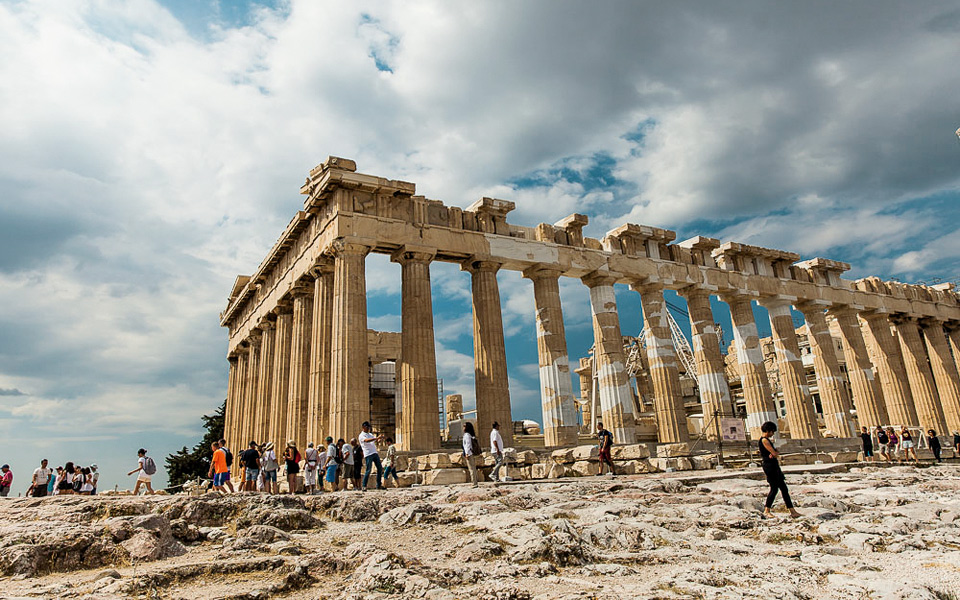Neoclassical Architecture: From Greece to the World
Discover how ancient Greek architecture inspired...

The Parthenon
© Dimitris Vlaikos
1. The aesthetic result is primarily due to two characteristics: evmetria (the perfectly balanced ratios of surfaces and volumes) and the use of architectural refinements.
2. The building’s architectural ratio of length-to-width is 9 to 4, a proportion that also appears throughout the temple in many of its lesser dimensions.
3. Optical refinements, particularly the curvature of horizontal and vertical surfaces, are at their most perfect in the Parthenon. They represent ingenious architectural solutions that result in the monument combining harmonious proportions and an imposing appearance with the temple’s setting at an angle to the hill. The intentional absence of any straight lines endows the monument with grace and vitality.
4. The fact that each of the temple’s 92 metopes was decorated with relief sculpture was unprecedented at that time.
5. The frieze depicting the procession of the Greater Panathenaia is generally thought to represent the three stages of the most sacred procession of the Athenians: on the west end, the preparations; along the two long sides, a cavalcade of horses and riders, sacrificial animals, musicians and members of Athenian society; while on the east end, the presentation of the sacred peplos, a scene attended by the 12 gods of Olympus.
6. The strikingly vivid rendering of the 360 figures depicted on the frieze, which had a total length of 160 meters and a height of just over 1 meter, reflects its creation as one of the proudest moments in the history of human art.
7. There may be two processions shown in the frieze, the first representing the original (pre-Cleisthenes) division of Attica into four tribes and the second its later division into 10 tribes. The frieze would thus balance the older traditions of the city’s past with its democratic present, as expressed in Pericles’ Funeral Oration recorded by Thucydides.
8. Only on the Acropolis were mortals (especially the Athenians themselves) depicted interacting with gods—if the Parthenon’s frieze actually shows the Panathenaic Procession and if the Athena Nike temple’s frieze shows historical, not mythical, battles.
9. The east pediment depicted the birth of Athena, while the west pediment illustrates the contest between the goddess and Poseidon. According to legend, Athena competed with the god of the sea for possession of the city of Athens. The central figures were larger-than-life, with Poseidon reaching a height of 3 meters.
10. The external appearance of the Parthenon was further enhanced by the polychromy of its sculptural decoration. The triglyphs were painted blue, as was also the background of the frieze, while the background of the metopes was white or red. In addition, all garments and objects were colored.
11. The Parthenon is such a sturdy construction that architect Manolis Korres, Greece’s leading scholar on the Acropolis, once remarked that it could support the entire weight of the aircraft carrier Nimitz, adding: “The ancients built for eternity.”
We advise you to begin your tour of ancient Athens at the Acropolis. Admission is €12, but this ticket also provides entrance to the other main archaeological sites. If you start somewhere else, you will pay separately for your admission there and then have to pay an additional €12 for the Acropolis.
• When the sun is strong and temperatures are high, it’s better to go early in the morning, definitely not at midday.
• No two structures on the Acropolis overlap, so each one has the appearance of a painting whose background consists entirely of the blue Attic sky.
• Because your visit will involve a fair bit of walking, particularly uphill, and the marble stones can be quite slippery, it is advisable to wear a good pair of rubber-soled shoes.
• Don’t forget to take a look at the olive tree behind the Erechtheion, which according to legend can be traced back to the original sacred tree of the goddess Athena.
• Tel. (+30) 210.321.4172
• Admission: Full: €12
• Reduced: €6 Includes admission to all the main archaeological sites in the historical center.
Discover how ancient Greek architecture inspired...
With its beautiful olive groves, emerald...
On the Cycladic island of Tinos,...